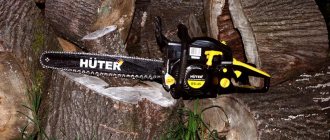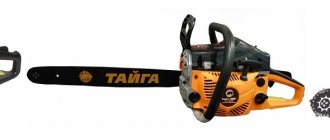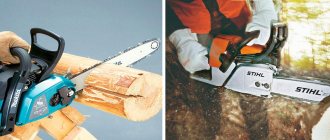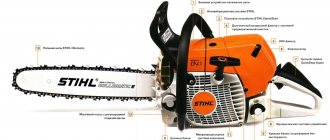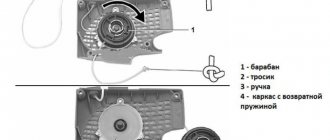Powered by gasoline | 05/20/2015
The process of cutting and sawing is in a person’s blood: starting from a loaf and sausage and ending with trees of three girths and blocks of marble. Without a high-quality and reliable chainsaw, which has gone through its centuries-old and still unfinished path of development, neither a master nor a professional can imagine his life and work. The sawing technique was mastered by primitive people eight thousand years ago with the understanding that a jagged tool cuts better than a smooth one. The oldest primitive saw that has survived to this day for sawing bone and wood was made from a single piece of silicon - such work required significant use of physical strength.
To process stone blocks, at the end of the Neolithic era, a silicon plate with teeth appeared, under which, during the sawing process, sand moistened with water and acting as an abrasive was sprinkled for better friction. Sawing through with such labor costs was not so necessary: the master made a deep cut, and then split the stone into two parts with a wedge-shaped mallet. It was thanks to the sawing technique that it became possible to give products the correct geometric shapes, which became an evolutionary breakthrough in technological and construction processes.
Historical development of the first chainsaw
The key elements that later went into the design of the very first chainsaw (Walter S. Shape's chain saw, tire, carburetor internal combustion engine) were invented at the end of the 19th century.
The progenitor of the modern chainsaw appeared relatively recently - at the beginning of the 20th century. In 1926, the famous German mechanical engineer and owner of a mechanical engineering company for the production of washing machines and steam boilers, Andreas Stihl, issued a patent for a mechanical chain saw equipped with an electric motor.
The patented chain saw weighed almost half a hundredweight and was operated by two physically strong operator workers. With all the powerful work of engineering, by 1929 it was possible to reduce its considerable weight by only a couple of kilograms. Shtil began to look for other ways to increase the power of the tool while reducing its weight and, as an experiment, decided to replace the electric motor with a gasoline one. In the same year, the inventor presented a test copy of a mechanical chain saw with an internal combustion engine with a power of 6 hp. and weighing 46 kg, it was the very first chainsaw in the world. This innovative direction became fundamental for the further evolution of the chainsaw - Shtihl filed a patent for the saw chain and tires he created, introduced into his own production a centrifugal clutch and a pressure oil lubrication system for chains.
In 1943, Stihl, commissioned by the Wehrmacht, produced the KS-43 two-handed chainsaw for military-strategic purposes. Particularly light, made of magnesium alloy, the air blower housing, fuel tank and float carburetor reduced the total weight to 36 kg.
In 1947, lumberjack and founder Joseph Buford Cox modernized the saw chain by developing a new C-shape of steel teeth.
As before, the heavy weight of the tool limited the demand for it among ordinary consumers, and until the end of the forties the saw remained in demand only as a professional tool for lumberjacks and builders. The ultra-light saw, released in 1950 by STIHL, weighing only 16 kilograms, produced the effect of a bomb exploding, and further improvements in the design made it possible in 1954 to introduce an even lighter 11-kilogram model with a two-stroke internal combustion engine onto the gardening tool market. And, from that moment on, the chainsaw became firmly entrenched in the household arsenal of home craftsmen.
1959 was the year of the creation of the gearless STIHL Contra, which became a legend among the first chainsaws with a diaphragm carburetor that allowed rotation of the saw in all spatial planes. The insignificant weight of 12.2 kg compared to previous models made it possible for the first time to be operated by one operator, increasing logging productivity significantly. Thus began the era of compact chainsaws.
In the 60s, chainsaws continued to improve: an anti-vibration system and an electronic ignition unit were developed, Husqvarna proposed the “two-mass” principle with the engine separated from the handle.
Developments of the 70s were aimed at creating the most comfortable conditions for those working with a chainsaw: a heated handle, a QuickStop brake for instantly stopping the chain, an automatic brake activated by inertial force, a single-lever control system, and a gas locking lever appeared.
In the mid-80s, a side chain tensioner, an Ematic chain lubrication system, an environmentally friendly BioPlus adhesive chain oil, and a catalyst for two-stroke engines were developed.
In the 90s, competition between STIHL and Husqvarna produced several landmark patents: tool-free chain tensioning and the centrifugal Air Injection air purification system.
The history of the chainsaw
There is no exact information about the time and circumstances of the appearance of the gasoline saw, but with a high degree of probability the prototype of the modern chain saw was a design invented at the end of the 18th century by two Scottish doctors, John Aitken and James Geoffrey, for amputating limbs in patients. A chainsaw-like tool was made around 1830 by German orthopedist Bernard Heine. A tool called an "osteotome" was designed to cut bones. Therefore, we can safely say that this instrument has crossed the three-hundred-year mark of its development.
The first chainsaw was equipped with a bar and chain that was driven manually. A chain saw with an electric motor was created and patented by German mechanical engineer Andreas Stihl in 1926. The power of such a chainsaw was 2.2 kW, and it weighed 48 kg. Three years later, the same Andreas Stihl created the Stihl gasoline saw, the power of which was 6 hp, and the weight dropped to 46 kg. In 1950, the Stihl company began producing one-handed chainsaws, equipped with a carburetor and adjustable, their weight was 16 kg.
Four years later, the production of sensationally light chainsaws weighing 11 kg at that time was launched. With their help, they began to carry out not only felling and bucking, but also pruning branches. The weight of the chainsaw was reduced due to the two-stroke engine invented by the Emmerick brothers. 1958 was marked by the appearance of a diaphragm carburetor on gasoline saws, allowing the saw to be used in any position. By the early 60s, several companies produced chainsaws, including the well-known Husqvarna. For ten years, gasoline saws from this manufacturer have been equipped with an anti-vibration system, electronic ignition, and a self-lubricating chain. Since 1972, every chainsaw has had a chain brake. Since then, they have been developing towards specialization and improving consumer properties. Modern chainsaws have retained a lot from the past. Thus, they have an automatic chain brake that stops the saw when the end of the bar suddenly comes into contact with the object being cut. It is made in the form of a lever-shield, which is installed in the cocking position before starting work. During an impact, the shield moves with the inertial movement of the handle to the brake position, due to which the chain quickly stops.
Each model has automatic chain lubrication. In addition, some chainsaws also have regulation of the amount of lubricant supplied to the chain, this is determined by the degree of resistance of the object being cut. A modern garden tool with a power of 1.5-2 hp is designed for light operations; professionally it is used only for pruning branches. For more difficult types of work, such as felling trees, chainsaws with a power of 2-4.5 hp are used. However, the main achievement of modern gasoline saws is their lighter weight (from 3 kg), due to which chainsaws have become much more convenient compared to their predecessors.
Chainsaw
| This section is missing references to information sources. Information must be verifiable, otherwise it may be questioned and deleted. You can |
The key structural elements of a chainsaw (chainsaw, bar, internal combustion engine) were created at the end of the 19th century. The practical use of the “saw set” has been going on since the beginning of the 20th century, while other types of drives were used: pneumatic, steam, mechanical, etc.
There is no reliable information about the first manufacturer of the chainsaw, and this right is disputed by several modern manufacturers. The most proven fact is that Andreas Stihl (Trademark Stihl) began producing gasoline-powered hand-held chainsaws in the late 1920s. At the very beginning of the 20th century, large chain sawmills were made that were driven by hand. All chain saws of that time, created for felling wood, were large, clumsy machines that were operated by at least two people. Many attempts have been made to create a powerful chain saw for cutting down trees. And finally, in 1926, German mechanical engineer Andreas Stihl created and patented the first hand-held chain saw with an electric motor. The instrument, Stihl, was named after him. In 1927, German entrepreneur Emil Lerp presented to the world his new development - Dolmar, model A. The instrument was equipped with a 245 cm3 engine with an output of 8 liters. With. and weighed 58 kg. It was the world's first gasoline-powered chainsaw. Dolmar is the name of the mountain in Thuringia where the first chainsaw test took place. Two years later, Andreas Stihl, continuing to develop tools for felling trees, released his chain saw with a gasoline engine.
Chainsaws in the USSR
The Soviet Union began purchasing foreign chainsaws (Rinco and Stihl) in the late 1920s. In 1935, the production of MP-220 chainsaws was mastered at the Perm plant named after Dzerzhinsky.
In the pre-war period, the war years and the first post-war period, chainsaws were not widely used in forestry, but this period played a positive role in the development of domestic chainsaws [1]:
- specialists who developed domestic gas and electric saws in the 1930s, after the war created the K-5 electric saw and the Druzhba chainsaw
- experience has been accumulated in the development of mechanized felling technology
- sections on chain saws appeared in the curriculum
- a plant appeared, which since 1935 has been developing and serially producing chainsaws
The import of chainsaws from abroad and the start of their own production did not affect the nature of the Soviet economy; the bulk of logging in the USSR was done by prisoners in forced labor camps; the hard labor of prisoners in taiga logging did not undergo practically any mechanization. Until the mid-1950s, trees were felled with hand-held bow saws in extremely unfavorable weather and climatic conditions, usually waist-deep in snow or knee-deep in swamp slush, as this was required to fulfill production plans. In 1951-1952 “VAKOP” electric saws, weighing 12 kg each, began to be introduced, but forest fellers refused them and, to prove their rightness, they competed to see who could cut down a tree faster - with a “VAKOP” or a “beam”, and in most cases the winner was the latter, the “beam”. By 1954, the “beam” fell out of use, gradually being replaced by electric saws K-5, K-6, for which temporary power lines were laid across the workshop areas. Later, felling was carried out with Druzhba and Taiga chainsaws, which did not require power lines and were lighter [2].
HISTORY OF THE INVENTION OF THE CHAINSAW
HISTORY OF THE INVENTION OF THE CHAINSAW The history of the emergence of technical solutions is interesting and multifaceted, and sometimes resembles a detective novel with a skillfully twisted plot. In any case, even behind the dry listing of facts and dates there is the genius of the creator, sometimes not always captured on the pages of history. But the history of the appearance and development of the chainsaw design has preserved the names. What stages of development has the “forest worker”, irreplaceable today, gone through? Even at the beginning of the twentieth century, the process of cutting down trees was a rather serious problem. Few could boast of any technical device to perform this difficult work. Technological progress has forced people to think about how to make the work of lumberjacks less labor-intensive. It is difficult to say who exactly invented the chain saw first. It is a well-known historical fact that such an instrument was created in 1830 by the German prosthetist Bernard Hein. He invented a surgical instrument for cutting bone. The principle of its operation was as follows: a chain of links fastened together with cutting teeth set at an angle was driven by a sprocket handle. At the very beginning of the twentieth century, large chain sawmills were made that were driven by hand. All chain saws of that time, created for felling wood, were large, clumsy machines that were operated by at least two people. Many attempts have been made to create a powerful chain saw for cutting down trees. And finally, in 1926, German mechanical engineer Andreas Stihl created and patented the first hand-held chain saw with an electric motor. The instrument, Stihl, was named after him. In 1927, German entrepreneur Emil Lerp presented to the world his new development - Dolmar, model A. The instrument was equipped with a 245 cm3 engine with an output of 8 liters. With. and weighed 58 kg. It was the world's first gasoline-powered chainsaw. Dolmar is the name of the mountain in Thuringia where the first chainsaw test took place. Two years later, Andreas Stihl, continuing to develop tools for felling trees, released his chain saw with a gasoline engine. Thanks to the advent of the gasoline engine, the saw became autonomous. However, the instrument still remained quite bulky and heavy. In 1935, production of the first chain saw with an electric motor began, which could be operated by one person - the Dolmar DB35. And only 17 years later (in 1952) its gasoline analogue appeared - the Dolmar CP model. In 1957, another technical solution was first introduced into the Dolmar CF model, which is still used in the production of chainsaws today - a membrane carburetor, thanks to which the saw could be used in both vertical and horizontal positions. In 1958, the Emmerich brothers, founders of the Solo company (Germany), installed a two-stroke engine for motorized sprayers, which they had been producing for about 10 years, on a chainsaw, which was called Solo REX. The Emmerick brothers managed to turn the engine with the drive shaft directly to the saw headset. The chainsaw not only received a compact and powerful engine, but also got rid of the bulky gearbox, due to which its weight was significantly reduced. Before this modernization, the crankshaft of the engine in chainsaws was located along the axis of the tool and required an angular transmission for the chain drive. The first mass-produced saw without a gearbox was the REX chainsaw from Solo. It was she who became the prototype of all gearless chainsaws produced to this day. The year 1959 was significant in the history of the development of the industry. Stihl develops a gearless chainsaw - the Stihl CONTRA, which later became one of the key and most successful models in the history of the brand. In the same year, another strong player appeared on the chainsaw market. One of the oldest companies in the world, the Swedish company Husqvarna, which at that time had extensive experience in developing two-stroke engines for motorcycles, presented the world with its first chainsaw - the A90 model. Although Husqvarna joined the chainsaw “society” later than other participants, its many years of experience combined with an innovative approach have always placed it at the forefront, regardless of whether they produced weapons or sewing machines, motorcycles or household appliances. Chainsaws were no exception. So, in 1962, Husqvarna began production of the ultra-light model “70” weighing only 5.5 kg, which could be used both for felling and bucking timber, and for trimming branches and twigs. Already in 1969, Husqvarna released the 180 model, the world's first chainsaw built on the principle of two masses with an integrated vibration system. However, the 60s of the twentieth century became a “turning point” in the production of chainsaws. If before this the innovators in terms of developing new products in the industry were the companies Solo, Stihl and Dolmar, then in 1960 the initiative was seized and to this day are firmly held in their hands by two companies - Stihl and Husqvarna. These two truly worthy competitors still define the “fashion” among chainsaws to this day. It was the competition between them and equal positions in the market that contributed to the rapid development of chainsaws, as well as other equipment for forests and gardens. Facts and Dates 1964 - Stihl Anti-Vibration System. 1969 - Husqvarna's "two-mass" principle, which became standard for all modern chainsaws (according to this principle, the engine is separated from the handles by vibration damping elements). 1972 - Stihl introduces QuickStop, a hand-activated chain stop system. 1973 - Husqvarna develops an automatic chain brake that is activated not only by hand, but also by inertial force (standard for modern saws). 1990s — Stihl introduces a tool-free chain tensioner, Husqvarna registers and implements a patent for the Air Injection system - a pre-centrifugal air purification system that significantly increases the intervals between air filter cleanings. 2004 - Husqvarna launches into mass production equipment with 2-stroke engines built using new X-TORQ® technology. 2006 - Stihl launches the MS441 chainsaw with 2-MIX® engine. Both technologies provide a more than 2-fold reduction in exhaust gas volume and fuel economy. This list can be continued for a long time, since the competition between manufacturers continues today. And there is only one winner in this competition - the user, for whom Emil Lerp created the world’s first chainsaw back in 1927...
The history of the chainsaw
Chainsaw - history of creation. Introduction.
There is a list floating around the RuNet that contains interesting questions like: “Why is the word “abbreviation” so long?” or “Why do you need to click on START to finish working in Windows?” The other day I was thinking about an equally difficult question: “When was the first chainsaw made?”
It would seem a simple question. But there was no answer to it.
The world's first chainsaw
It turns out that many modern manufacturers of this wonderful machine claim the right to be considered the inventor of the chainsaw, but only one of them can be right. I had to look for it myself.
A search on the Russian and English-language Internet did not yield any results. More precisely, he almost didn’t. I learned that chainsaws appeared in the 1920s and that it was during this period that they were "first created" by most of those who claim to be the "Creator of the Chainsaw." I also learned that long before I was born, very reputable magazines wrote that chainsaws were a very old invention and provided photographs to prove it.
But there was a problem. Those who talked about this could accurately name the magazine number, page, describe what was shown in the photograph and what was written under it, BUT there were no photographs themselves (or there were, but their quality was even worse than the filming of lunar expeditions). In general, I had to take matters into my own hands and move the mouse.
Mysterious photo
Half an hour and two cups of tea later, the mysterious photograph was discovered.
Cover of Scientific American, January 22, 1910: Saw-Driven Engine Cutting Redwood. My state: euphoria bordering on shock. It turns out that 100 years ago people no longer lived in the Stone Age, but could create very complex units. And the fact that the chain saw bar was the same then as it is now does not fit into any gates. The most important question is: What does it work on? It’s not visible in the picture, but by that time the carburetor internal combustion engine was at least twenty years old.
If anyone doesn’t know, a “tire” is a thing that sticks out of the saw and along which the chain runs.
Honestly, I don’t know what that saw worked on, but I’ll definitely find out. After all, I have already passed a significant part of the path to this Knowledge.
Due to the impossibility of discovering the Creator of the saw, I took a roundabout route.
Night One: The Trailblazers
At the suggestion of my colleagues (they gave me the idea and then went home to bed!) I began patent research. It turned out that on the Internet you can access the US patent library and familiarize yourself with documents dating back to 1790.
Over the next hours, I got acquainted with the formats of American patents, how the requirements for filing patents have changed over the past 100 years, with the principles of constructing a patent classifier, and found out which section of the classifier I needed. I became a patent search master. But I never found out who was the first to make a chainsaw. I didn’t even find out who patented it first. But as a result, I almost wrote a review on the history of chainsaws.
A summary of the first draft of the first part of "The World History of Chainsawing", which was almost written, but never saw the light of day.
— A chainsaw is essentially a “chainsaw.” This means that in order to find the inventor, you just need to find out who was the first to attach a gasoline engine to a chain saw. All that remains is to trace the stages of evolution of chain saws “from amoeba to man”
— On September 1, 1885, a certain Walter S. Shipe patented a chain saw. He did not bother to indicate how or what to attach it to, but said that it is best to connect a horse or a steam engine to the saw. Horse-drawn chainsaw? After all, the Stone Age was not so long ago!
- On October 7, 1902, the cunning John Arthur Brines received a patent for a mobile saw. She rode on a wheel and, instead of the tire we know, had a U-shaped frame. Without straining too much with the engine, he gave a vague formulation, saying “any engine suitable for our business will do.” In addition, he gave the name to his invention “Sawing apparatus”.
I didn’t want to recognize such a “device” as the first chainsaw, and I told myself that the internal combustion engine in 1902 had to be the size of the Winter Palace and therefore could not fit on John’s gurney.
— Finally, after the Great October Socialist Revolution, a saw worthy of being the ancestor of the chainsaw was born.
A real hand-held compact saw, with a modern bar and chain. Moreover, it is manual in the literal sense of the word, because it is activated by rotating the handle. There is only one step left to reach the cherished goal - attach the motor.
- This is a discovery. I never would have thought. That's how dense the Middle Ages are.
Just think, already in 1930, a decent saw with a normal layout and, moreover, ELECTRIC. And by the way, gasoline ones are not seen for another 5 years, but those that are on the antediluvian U-shaped frame. Here it is, the greatest scientific discovery of our time: electric chain saws appeared before gasoline ones.
Having reached the discovery of the primacy of the electric saw in front of the chainsaw, I decided that I was doing something wrong and decided to go to bed, fortunately it was already morning and the time had come when normal Internet users go to bed. In addition, the 1910 car suggested that progress was going faster than I saw. I decided to dig deeper this morning. I wish I hadn't done this.
Greenpin swamp: step right, step left...
In the morning/lunch, not fully awake, I started digging around. The very first swings of the shovel showed that I know very little about the patent classifier, but I have a lot to say about the intimate life of the parents of the classifier’s creators. Chainsaws were distributed evenly throughout the classifier and were present everywhere, except for the category where it was written “Chain Saw”.
First, a 1911 patent for an electric chain saw was discovered, then in 1912-13, detailed drawings of chain saws with steam and pneumatic drives were discovered. Although they were on a U-shaped frame, they were drawn down to the last screw, which gave hope that these units were embodied in hardware.
Then a 1905 patent for a pneumatic chain saw was discovered. And we can say that structurally it was a saw with a bar.
The world was collapsing. In the next half hour, I found a patent for a bar from 1883 (against the original chain from 1885), and then a full-fledged sawmill on a chain saw from 1868.
In general, I had to abandon the almost written first version of “The World History of Chainsawing” and immediately start writing the second version. I would like to hope that I can do this before I accumulate materials for the third one.
- Author: Olga
Rate this article:
- 5
- 4
- 3
- 2
- 1
(2 votes, average: 3 out of 5)
Share with your friends!
